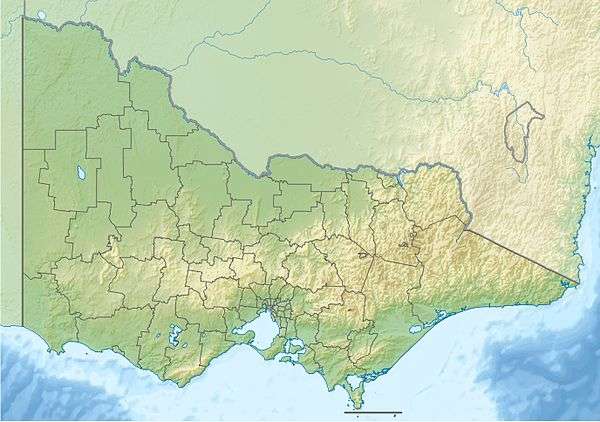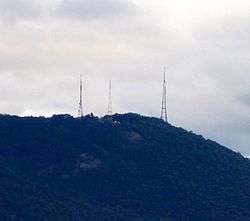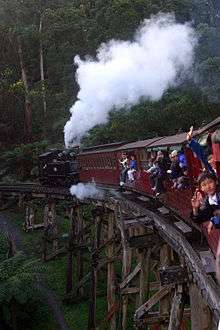Dandenong Ranges
The Dandenong Ranges (commonly just The Dandenongs) are a set of low mountain ranges, rising to 633 metres at Mount Dandenong, approximately 35 km (22 mi) east of Melbourne, Victoria, Australia. The ranges consist mostly of rolling hills, steeply weathered valleys and gullies covered in thick temperate rainforest, predominantly of tall Mountain Ash trees and dense ferny undergrowth.
| Dandenong Ranges | |
|---|---|
| Corhanwarrabul, The Dandenongs | |
 Left - Mount Dandenong and right - Mount Corhanwarrabul, viewed from Mooroolbark | |
| Highest point | |
| Peak | Mount Dandenong |
| Elevation | 633 m (2,077 ft) |
| Coordinates | 37°49′36″S 145°21′17″E |
| Dimensions | |
| Length | 50 km (31 mi) N-S |
| Width | 10 km (6.2 mi) E-W |
| Geography | |
 Location of the Dandenong Ranges in Victoria | |
| Country | Australia |
| Region | Victoria |
| Range coordinates | 37°50′S 145°21′E |
| Parent range | Great Dividing Range |
| Geology | |
| Age of rock | Devonian |
| Type of rock | Igneous, Sedimentary and Metamorphic |
After European settlement in the region, the range was used as a major source of timber for Melbourne. The ranges were popular with day-trippers from the 1870s onwards. Much of the Dandenongs were protected by parklands as early as 1882 and by 1987 these parklands were amalgamated to form the Dandenong Ranges National Park, which was subsequently expanded in 1997. The range receives light to moderate snow falls a few times in most years, frequently between late winter and late spring.
Today, The Dandenongs are home to over 100,000 residents and are popular amongst visitors, many of whom stay for the weekend at the various Bed & Breakfasts throughout the region. The popular Puffing Billy Railway, a heritage steam railway, runs through the southern parts of The Dandenongs.
Etymology
The etymology of the Dandenongs is a complicated one. Two names have been used to refer to the ranges; Corhanwarrabul and Dandenong, both derived from the Woiwurrung language of the Wurundjeri people.
It is suspected that the name Dandenong was applied to the ranges due to being the origin of the Dandenong Creek; however, the original name for Dandenong Creek was Narra Narrawong. The origin of the name Dandenong is unknown, as is its meaning or correct spelling with other variations include; Tanjenong, Tangynon and Bangeong. In any case, both names relate to watercourses rather than mountains or ranges, as indicated by the ong ending. Given that the name Dandenong may not apply to anything in the immediate area, the relevance of the name Corhanwarrabul becomes apparent. Carhanwarrabul (pronounced either "corhan-warrabul" with a silent "h", or "cor-hana-warrabul") was the original name for one of the two main summits, perhaps both or perhaps the entire range. The name applied to the main summits and was in continued use up until around 1900, when the name Dandenong appeared. At any rate, Corhanwarrabul remains the most relevant name for the ranges to date.
Geology and ecology
The range is the remains of an extinct volcano last active 373 million years ago.[1] It consists predominantly of Devonian dacite and rhyodacite.
The topography consists of a series of ridges dissected by deeply cut streams. Sheltered gullies in the south of the range are home to temperate rain forest, fern gullies and Mountain Ash forest Eucalyptus regnans, whereas the drier ridges and exposed northern slopes are covered by dry sclerophyll forest of stringybarks and box. The entire range is highly prone to bushfires, the most recent of which have been the 1983 Ash Wednesday bushfires, the 1997 Dandenong Ranges bushfires and small fires during the Black Saturday bushfires in 2009.
A number of watercourses originate in the Dandenongs, these include:
- Cardinia Creek
- Clematis Creek
- Dandenong Creek
- Emerald Creek
- Ferny Creek
- Mast Gully Creek
- Menzies Creek
- Monbulk Creek
- Muddy Creek
- Olinda Creek
- Sassafras Creek
- Sherbrooke Creek
- Stringy Bark Creek
- Wandin Yallock Creek
- Woori Yallock Creek
Waterfalls
- Olinda Falls
- Sherbrooke Falls
- Griffith Falls
Summits

| Summit Name | Height (m) | Comments | Location | Source[lower-alpha 1] |
|---|---|---|---|---|
| Mount Dandenong | 630 | Tallest peak of the Dandenongs | Observatory Road, Mt Dandenong | DANDENONG ECC J survey mark |
| Mount Corhanwarrabul | 612 | Burkes lookout and location of transmission towers | Burkes Lookout Reserve, Eyre Road, Mt Dandenong | contour data |
| Olinda summit | 592 | No official name. Labelled Mt Olinda in older tourist maps. | Range Road, Olinda | contour data |
| Sassafras peak | 538 | No recorded name. | Cooloongatta Road, Sassafras | contour data |
| Dunns Hill | 562 | Location of a number of radio and telephone towers. | One Tree Hill Road, Ferny Creek | contour data |
| One Tree Hill | 500 | Lord Somers Road, Ferny Creek | contour data | |
| Tremont Hill | 395 | No official name. | Tremont Hill Track, Tremont | contour data |
| Chandlers Hill | 405 | Chandlers Track, Tremont | contour data | |
| Johns Hill | 419 | Johns Hill Reserve, Ridge Road, Kallista | JOHNS HILL ECC 1986 survey mark | |
| Black Hill | 374 | Black Hill Reserve, Two Bays Crescent, Selby | contour data | |
| Upwey Hill | 278 | Belmont Street, Upwey | contour data | |
| Lewis Hill | 298 | Queens Road, Silvan | contour data | |
| Nobelius Hill | 320 | Ambrose Street, Emerald | contour data | |
| Mount Morton | 275 | Chaundy Road, Belgrave South | MORTON ECC A survey mark |
- Survey mark and counter data has been accessed from the State of Victoria Land and Survey Spatial Information[2]
Climate
The Dandenong Ranges climate is generally mild and wet, with daily temperature variation generally low, often as low as 1 degree in the winter months. Rainfall is fairly uniform through the year, tending to peak between April and October with lower rainfall during the months of January and February. The mean annual rainfall is between 1000 and 1500 mm, increasing with elevation and from west to east.[3] The elevation means that temperatures are typically 2 to 5 °C cooler than the lower suburbs of Melbourne to the west , with temperatures typically lowering by 1 °C for every 150 m of elevation. Due to the elevation, fog is common in winter months.
As a result of its elevation, snow typically falls one or two times a year at higher elevations, mostly between the months of June and October. A rare summer snow occurred on Christmas Day 2006 . The local region has experienced substantial warming in recent decades and heavy snowfalls which were once common have become rare. The last significant snowfall to affect the Dandenong Ranges was on August 10, 2008, when as much 15 cm (5.9 in) fell at the highest elevations.
A Bureau of Meteorology weather station sits at an elevation of 513 m in the Ferny Creek Reserve in the southern part of the Dandenong Ranges. This weather station replaced one that was previously located on the summit of Dunns Hill.

| Climate data for Mount Dandenong | |||||||||||||
|---|---|---|---|---|---|---|---|---|---|---|---|---|---|
| Month | Jan | Feb | Mar | Apr | May | Jun | Jul | Aug | Sep | Oct | Nov | Dec | Year |
| Record high °C (°F) | 37.3 (99.1) |
39.3 (102.7) |
33.6 (92.5) |
28.0 (82.4) |
20.3 (68.5) |
15.0 (59.0) |
16.0 (60.8) |
20.0 (68.0) |
22.7 (72.9) |
28.7 (83.7) |
33.2 (91.8) |
36.2 (97.2) |
39.3 (102.7) |
| Average high °C (°F) | 22.1 (71.8) |
22.9 (73.2) |
19.7 (67.5) |
15.4 (59.7) |
11.7 (53.1) |
8.8 (47.8) |
8.2 (46.8) |
9.6 (49.3) |
11.6 (52.9) |
14.8 (58.6) |
17.3 (63.1) |
19.9 (67.8) |
15.2 (59.4) |
| Average low °C (°F) | 11.5 (52.7) |
12.6 (54.7) |
11.3 (52.3) |
9.0 (48.2) |
6.0 (42.8) |
4.4 (39.9) |
3.6 (38.5) |
4.2 (39.6) |
5.0 (41.0) |
6.8 (44.2) |
8.3 (46.9) |
9.8 (49.6) |
7.8 (46.0) |
| Record low °C (°F) | 4.0 (39.2) |
4.7 (40.5) |
3.7 (38.7) |
0.7 (33.3) |
−0.4 (31.3) |
−1.0 (30.2) |
−2.3 (27.9) |
−2.0 (28.4) |
−1.8 (28.8) |
−0.6 (30.9) |
0.5 (32.9) |
2.3 (36.1) |
−2.3 (27.9) |
| Average rainfall mm (inches) | 70.2 (2.76) |
61.2 (2.41) |
74.6 (2.94) |
102.0 (4.02) |
129.6 (5.10) |
98.4 (3.87) |
95.5 (3.76) |
116.8 (4.60) |
106.0 (4.17) |
104.8 (4.13) |
109.4 (4.31) |
95.7 (3.77) |
1,164.2 (45.84) |
| Average rainy days (≥ 0.2mm) | 12.1 | 8.4 | 12.4 | 13.7 | 18.2 | 17.8 | 20.0 | 19.7 | 17.5 | 16.5 | 15.2 | 12.9 | 184.4 |
| Source: Bureau of Meteorology[4] | |||||||||||||
Settlements in the Dandenong Ranges
Around 120,000 people live in and around the Dandenong Ranges, depending on the definition. The following settlements are located in the Dandenongs themselves (72,500~):
- Belgrave—3929[5]
- Belgrave Heights—1,500
- Belgrave South—1,500
- Clematis—3,800
- Emerald—6,000
- Ferny Creek—1,500
- Ferntree Gully - 10,000
- Kallista—1,000
- Kalorama—1,100
- Kilsyth—10,000
- Menzies Creek—1,300
- Monbulk—2,700
- Montrose—6, 500
- Mount Dandenong—1,300
- Olinda—1,500
- Sassafras—1,000
- Selby—1,400
- Tecoma—2,200
- The Patch—800
- Upper Ferntree Gully—4,000
- Upwey—6,800
Some settlements located on and around the plateau to the east of the ranges are sometimes included (14,200~):
- Cockatoo—4,500
- Gembrook—1,600
- Macclesfield—1,600
- Seville—2,000
- Seville East—600
- Silvan—1,900
- Wandin East—500
- Wandin North—1,600
Settlements in the western foothills are also sometimes included (34,500~):
- The Basin—4,100
- Boronia—20,500
- Mount Evelyn—9,100
Human History
The ranges are located near the boundary between the Wurundjeri and Bunurong nations' territories. The two nations were part of the Kulin alliance and were most often on friendly terms. The mountain range, however, was not often frequented by either nations people as mountainous areas were often considered one of many resting places for various spirits.
In 1938, the aircraft Kyeema crashed on the western face of Mount Corhanwarrabul due to heavy fog and poor navigation. Eighteen people died.[6]
Utilities
Transmission towers
There are several large television transmission towers on various summits that were initially constructed to broadcast TV to Central Victoria
- Channel 10/Channel 0, 204m high—Mount Corhanwarrabul (628m), (highest frequency)
- Channel 9, 131m high—Mount Corhanwarrabul (628m)
- Channel 7, 131m high—Mount Corhanwarrabul (628m), this tower is from interesting design, as it is a partially guyed tower, consisting of a free-standing lattice tower as basement and a guyed mast as pinnacle.
- Channel 2—Ferny Creek Summit (561m) (lowest frequency)
Tourism and attractions
- Scenic drives—popular for many years on the abundance of winding roads throughout the ranges
- Picnics—dedicated picnic areas can be found in Fern Tree Gully Picnic Ground or at One Tree Hill or in Sherbrooke Forest
- The various coffee shops and restaurants, bed and breakfasts, craft shops, antique shops and gardens
- Puffing Billy Railway—a narrow-gauge heritage steam railway, from Belgrave, through to Emerald, and ending at Gembrook
- Lookouts & views—There are several locations throughout the ranges that offer excellent views on both sides of the range. On a clear day, features as far as Mount Macedon, the You Yangs and Port Phillip can be seen simultaneously
- Walking & hiking—various tracks and trails are available at a variety of lengths and difficulties
- Cycling—the Dandenong Ranges are one of Melbourne's most popular cycling areas. Popular road cycling climbs include the "1 in 20" on the Mountain Highway, "The Wall", a steeper route between Monbulk and Olinda, and the also-steep "Devil's Elbow", heading north from Upper Ferntree Gully along the Mount Dandenong Tourist Road to Ferny Creek
Regulations
Camping is not permitted within the National Park and fire restrictions may apply during the summer months. There are no rubbish bins in the national parks and visitors must leave with all items that they arrived with.
Bushfires
Due to the climate of the region, the type of vegetation and the topography, the Dandenong Ranges periodically experience bushfires. Some of the recent occurrences included:
- 1851—Black Thursday
- 1898
- 1905
- 1913
- 1926
- 1939
- 1962
- 1968
- 1983—Ash Wednesday, 27 deaths in the Dandenong ranges
- 1997—3 deaths in the ranges
- 2009—Black Saturday, no deaths in the ranges
Gallery
 The 1000 steps
The 1000 steps Puffing Billy on the Trestle Bridge
Puffing Billy on the Trestle Bridge View of Melbourne from the summit of Mount Dandenong
View of Melbourne from the summit of Mount Dandenong- View of Melbourne from the summit of Mount Dandenong
- Mount Dandenong as seen from Kilsyth
 Transmission towers on the summit of Mount Corhanwarrabul
Transmission towers on the summit of Mount Corhanwarrabul- Transmission towers. Note that the upper parts of the tower in the background are guyed.
 Channel 10 transmission tower
Channel 10 transmission tower- Channel 9 transmission tower
- Channel 7 transmission tower
- The Silvan Reservoir looking east from Kalorama
References
- Birch, William D. (1994). Volcanoes in Victoria. Royal Society of Victoria. ISBN 0730606279.
- https://maps.land.vic.gov.au/lassi/ Land and Survey Spatial Information, State of Victoria (Department of Environment, Land, Water and Planning). Accessed 15 June 2020.
- "Climate statistics for Australian locations - Dunns Hill". Australian Government Bureau of Meteorology. Retrieved 24 September 2017.
- "MOUNT DANDENONG GTV9". Climate statistics for Australian locations. Bureau of Meteorology. May 2013. Retrieved 1 June 2013.
- "2016 Census QuickStats: Belgrave". quickstats.censusdata.abs.gov.au. Retrieved 3 June 2020.
- "The Crash of Kyeema" (PDF). Flight safety Australia. November 1998. Archived from the original (PDF) on 29 September 2007. Retrieved 24 September 2017.
External links
| Wikivoyage has a travel guide for Dandenong Ranges. |
- Blue Dandenongs
- Parks Victoria
- Info sourced from Knox Historical Society on place names in the area
- The dandenongs in colour
| Wikimedia Commons has media related to Dandenong Ranges. |